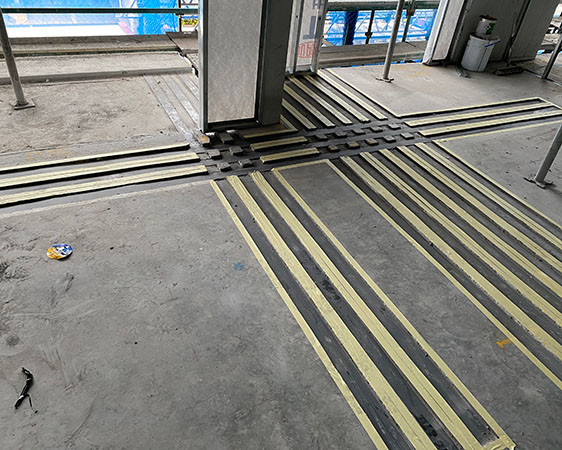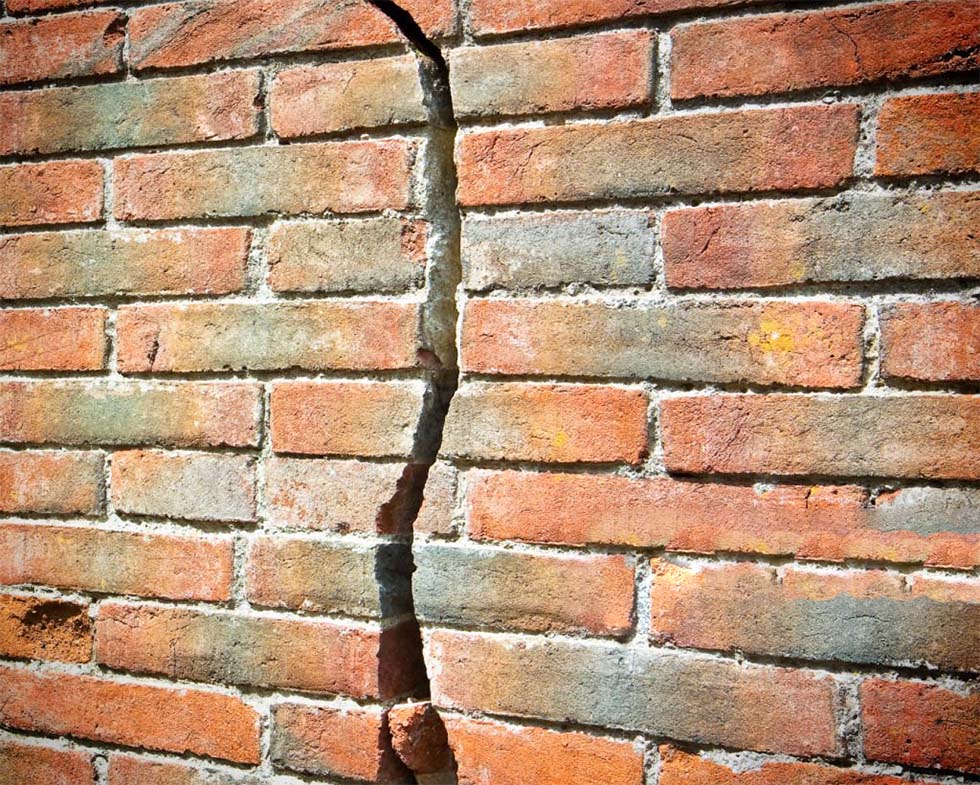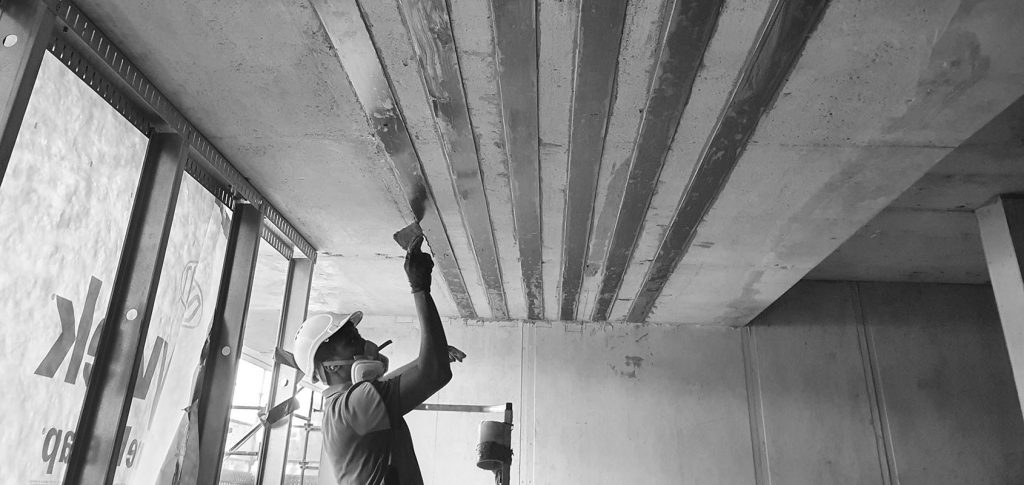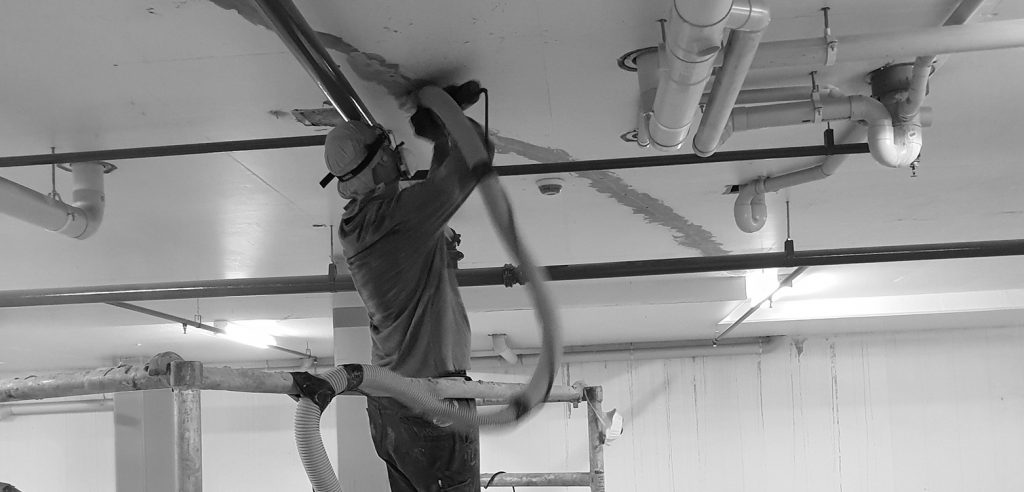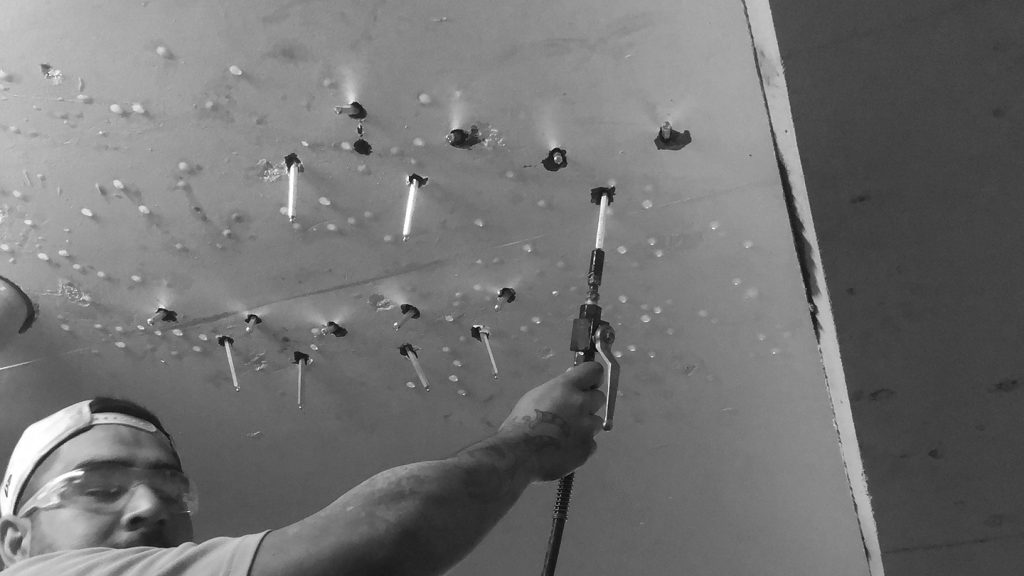Description: Repair of Reservoir Tank.
Elements: Crack Injection, Cathodic Protection and Waterproof Membrane

Scope of Works
External crack repair methodology:

- Mark out repair areas.
- Square cut to a minimum of 10mm
- Scabble back to sound concrete
- Expose corroding reinforcement
- Break out concrete to a minimum of 25mm behind bar.
- Grit blast reinforcing
- Replace corroded reinforcement if necessary
- Rout non-moving cracks to minimum of 10mm
- Install anodes to steel reinforcement at 300mm centres
- Check continuity of anodes to steel
- Coat steel with primer
- Pre-soak concrete substrate
- Apply specified bonding agent to concrete only
- Apply specified render material to prepared cracks
- Re-apply any dried bonding agent
- Cure render material immediately after finishing each repair.
Internal crack repair methodology
- V-grind out cracks to 25mm
- Brush specified waterproofing system into base of prepared crack
- Trowel apply specified mortar to re-profile crack
- Damp cure repair material with wet hessian for five (5) days
Rehabilitation of Internal Floor and Wall
- Polymer Modified Membrane to be coated onto internal wall and floor of the Water Tank.
- The VersEseal range seals invisible and hard to find leaks in water storage systems with a non-toxic chemical-resistant coating.
- VersEseal may be used on already damaged water tanks or can seal new structures to extend the life of the tank or liquid storage structure, protecting metal from corrosion.
- Application of VersEseal’s Waterproof Membrane System is straightforward, environmentally safe and free from hazardous fumes.
- It can be applied in confined spaces without the heavy duty personal protective equipment that some products require.

LRM Products VersEseal – Rapid Build
Heavy-duty textured waterproof sprayable & brushable coating for surface protection
VersEseal Rapid Build is a single component product that may be applied using a roller, squeegee or aggregate spray equipment. VersEseal Rapid Build is applied in thickness from 1.0 – 2.0mm.
LRM Products VersEseal – Rapid Build is a fluid applied polymer modified emulsion and is recommended for use in a variety of harsh environments, chemically exposed areas, temperature variations and high traffic areas.
VersEseal Rapid Build when cured fully adheres to the substrate to which it is applied, providing a flexible long wearing surface and is formulated for application by brush, roller, trowel or squeege.
Applications include concrete repair, expansion joints, foundation sealing, plumbing applications, retaining walls, roof repair, sewage pump stations, water tank membranes, reservoirs, waste water storage, civil pipe joints, UV protection.

Galvashield XPT
Embedded galvanic anodes are designed to provide localized corrosion protection. When placed at the appropriate spacing along the perimeter of concrete patches or along the interface between new/existing concrete, the anodes mitigate the formation of new corrosion sites in the existing concrete in adjacent areas.

Description
The Galvashield XP range of embedded galvanic anode units utilise an innovative zinc anode core design surrounded by an enhanced formulated cement-based mortar to provide corrosion mitigation to reinforced concrete structures. The anode units are alkali-activated (Type A) with an internal pH of 14 or greater to keep the zinc active over the life of the anode while being non-corrosive to reinforcing steel. The anode units utilise 2G Technology™ to provide higher current output. Once installed, the zinc anode corrodes preferentially to the adjacent reinforcing steel, thereby providing galvanic corrosion prevention or corrosion control.

Applications
Mitigates incipient anode formation (halo effect) in patch repair applications
Bridge widening and other structure modifications
Slab replacements, expansion joint repairs and other interfaces between new and existing concrete
Repair of prestressed and post-tensioned concrete
Chloride contaminated or carbonated concrete
Advantages
Proven technology – Galvashield has an extensive 10 year track record in the field
Type A anode – alkali-activated to maintain activity of zinc while being non-corrosive to reinforcing steel
Cast zinc core – provides high anode utilisation in addition to a secure long-term connection between the zinc and the lead wires
Integral steel lead wires – allows for quick and convenient anode installation. Provides dependable steel-to-steel contact with no intermediate materials such as galvanising (which can corrode over time) that may compromise the long-term electrical connection
BarFit™ design – grooved edges on Galvashield XP2 and XP4 anode units assist with secure anode placement
Economical – provides localised protection where it is needed the most, at the interface of the repair and the remaining contaminated concrete
Versatile – can be used for both conventionally reinforced and prestressed or post-tensioned concrete
Low maintenance – requires no external power source or system monitoring
Long lasting – 10 to 20 year service life* reduces the need for future repairs. *As with all galvanic protection systems, service life and performance is dependent upon a number of
factors including reinforcing steel density, concrete conductivity, chloride concentration, humidity and anode spacing.
Galvanic Anode Installation
- Install anode units and repair material immediately following preparation and cleaning of the steel reinforcement.
- Galvanic anodes shall be installed along the perimeter of the repair or interface at a spacing of (x mm) as specified on the drawings. Anode spacing will vary with changes in the reinforcing steel density, the level of chloride in the structure and the corrosivity of the local environment, etc.
| Note to Specifier: Typical spacing for Galvashield XPT ranges from 430-610 mm. The maximum anode spacing guidelines can be found on the Galvashield XP data sheet. Anode spacing should be adjusted for aggressive service conditions or for an extended anode service life. |
- Provide sufficient clearance between anodes and substrate to allow repair material to encase anode.
- Secure the galvanic anodes as close as possible to the patch edge using the anode tie wires. The tie wires shall be wrapped around the cleaned reinforcing steel and twisted tight to allow little or no free movement.
- If less than 25 mm of concrete cover is expected, place anode beside or beneath the bar and secure to clean reinforcing steel.
- If sufficient concrete cover exists, the anode may be placed along a single bar or at the intersection between two bars and secured to each clean bar.
- If repair materials with resistivity greater than 15,000 ohm-cm are to be used or the resistivity is unknown, create a conductive grout bridge between the anode and the substrate. Pack Galvashield Embedding Mortar to cover minimum area of 100mm in diameter between the anode and the substrate concrete ensuring no voids exist.
- Electrical Continuity
- Confirm electrical connection between anode tie wire and reinforcing steel by measuring DC resistance (ohm,W) or potential (mV) with a multi-meter.
- Electrical connection is acceptable if the DC resistance measured with multi-meter is less than 1 W or the DC potential is less than 1 mV.
- Confirm electrical continuity of the exposed reinforcing steel within the repair area. If necessary, electrical continuity shall be established with steel tie wire.
- Electrical continuity between test areas is acceptable if the DC resistance measured with multi-meter is less than 1 W or the potential is less than 1 mV.



